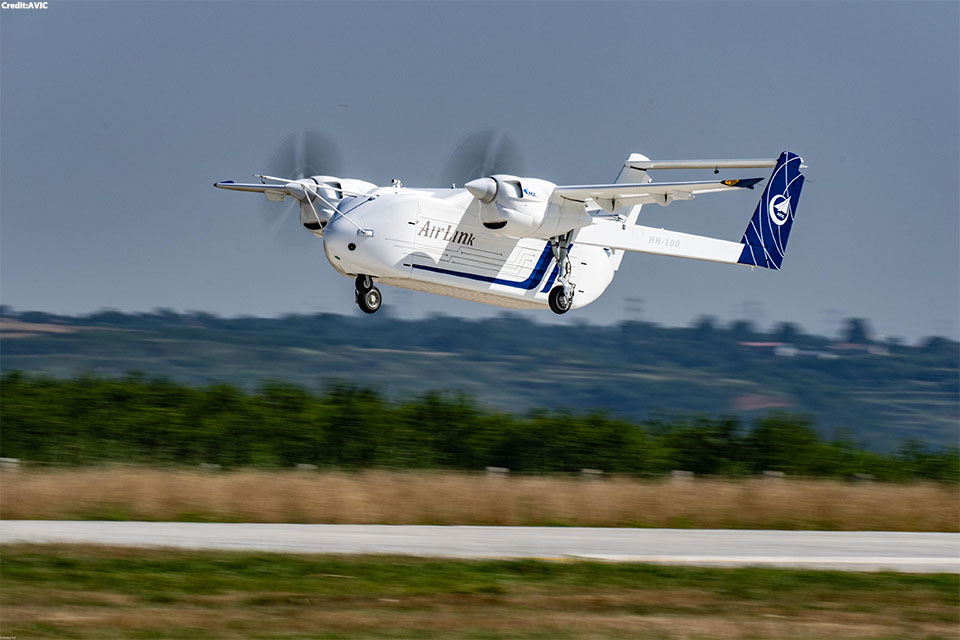Aviation
China’s Indigenous HH-100 UAS Successfully Completes First Flight

In a significant milestone for China’s aviation industry, the HH-100 aerial commercial unmanned transportation system successfully completed its maiden flight, as announced by the Aviation Industry Corporation of China (AVIC) on Wednesday.
The HH-100 demonstrator took to the skies for its inaugural flight at a general aviation airport in Xi’an, located in northwest China’s Shaanxi Province. This successful test was conducted by AVIC, China’s leading aircraft manufacturer, marking a pivotal step in the development of the country’s unmanned aerial vehicle (UAV) capabilities.
Developed independently by AVIC XAC Commercial Aircraft Co., Ltd., a subsidiary of AVIC based in Xi’an, the HH-100 consists of two main components: an unmanned aerial vehicle and a ground-based command-and-control station. This innovative system is designed to offer a cost-effective, high-payload solution for various transportation and logistical needs.
The HH-100 is notable for its low cost and large tonnage capabilities. With a designed maximum take-off weight of 2,000 kilograms and a payload capacity of 700 kilograms, it can transport approximately 4 cubic meters of cargo over a range of 520 kilometers. The drone’s maximum cruise speed is 300 kilometers per hour, and it can operate at altitudes up to 5,000 meters.
Primarily intended for feeder logistics, the HH-100 is also equipped to participate in a variety of other roles, including forest and grassland firefighting, fire monitoring, transportation and delivery of rescue materials, relay communication, and artificial rain enhancement. This versatility makes it a valuable asset in both commercial and emergency response operations.
Looking ahead, AVIC plans to develop a series of products based on the HH-100 platform, with models capable of carrying 5 tons, 10 tons, and even larger payloads. These future developments aim to meet the growing demand for large-scale, intelligent, low-cost, and highly reliable unmanned cargo planes.
The HH-100’s successful first flight marks an important achievement for AVIC and China’s aviation sector, showcasing the potential of homegrown technology to advance the country’s capabilities in unmanned aerial transportation. With its impressive range of features and applications, the HH-100 is poised to play a significant role in enhancing air-ground transportation connectivity and addressing various logistical challenges in the region.

Aviation
Airbus Plans Cockpit Toilet to Make Single-Pilot Operations a Reality

In a bold move aimed at cutting costs, Airbus is exploring the possibility of installing a potty-style toilet right behind the Captain’s seat on its A350 long-haul aircraft. According to the reports from paddleyourownkanoo.com
This proposal is part of the ongoing effort to implement Extended Minimum Crew Operations (eMCO), a concept that could revolutionize the aviation industry by reducing the number of pilots required on ultra-long-haul flights.
Air India Invests in Future Talent: 50,000 Staff to Be Trained at New Facility
Currently, on long flights, two pilots stay in the cockpit while the others rest in a separate compartment. However, under eMCO, one pilot could be alone in the cockpit for up to three hours while the other sleeps. The goal is to reduce crew costs and improve airline efficiency, as fewer pilots would be needed for these flights.
But this proposal has raised concerns from pilot unions, who worry about safety and the challenges of single-pilot operations. To address the issue of bathroom breaks, Airbus suggests installing a radio-equipped toilet in the cockpit, allowing the pilot to use it without leaving their seat.
UAE Visa: New Rules and Regulations – These Items Are Now Prohibited in the UAE
If the pilot needs to use the toilet, the second pilot would have to be woken up, terminating the eMCO process temporarily.
If successful, Airbus plans to begin testing this system on its A350 aircraft as soon as 2027, with single-pilot operations possibly being introduced on freighter Airbus A320s within the next five years.
-

 Aviation2 months ago
Aviation2 months agoMicrosoft Flight Simulator Raises $3 Million to Bring Back the An-225 Mriya
-

 Airlines2 months ago
Airlines2 months agoQatar Citizens Can Travel to the United States Without a Visa
-

 Defence2 months ago
Defence2 months agoWhich Country Has the Largest Fleet of Fighter Aircraft?
-

 Airlines1 week ago
Airlines1 week agoDAMAC Air: Dubai’s New Luxury Airline Offers Free Flights for Registration
-

 Airlines1 week ago
Airlines1 week agoAir India to Launch aircraft maintenance training institute in Bengaluru
-

 Airport2 months ago
Airport2 months agoWestern Sydney Airport Welcomes Its First Plane After 6 Years of construction
-

 Aviation2 months ago
Aviation2 months agoDid you know ? Once Boeing 747 carried 1088 passenger in 1991
-

 Travel1 week ago
Travel1 week agoThis country tops visa rejections in the popular Schengen countries








